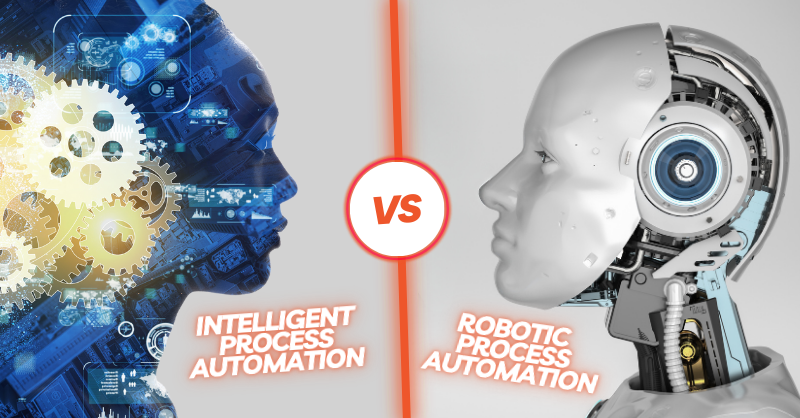Table of Contents
- Introduction
- Understanding Process Automation 2.1. What is Robotic Process Automation (RPA)? 2.2. What is Intelligent Process Automation (IPA)?
- Key Differences between RPA and IPA 3.1. Level of Autonomy 3.2. Decision-Making Capabilities 3.3. Use of Artificial Intelligence 3.4. Complexity of Tasks 3.5. Adaptability and Learning
- Use Cases of RPA and IPA 4.1. RPA Use Cases 4.2. IPA Use Cases
- Advantages and Disadvantages of RPA 5.1. Advantages of RPA 5.2. Disadvantages of RPA
- Advantages and Disadvantages of IPA 6.1. Advantages of IPA 6.2. Disadvantages of IPA
- When to Choose RPA
- When to Choose IPA
- Combining RPA and IPA for Enhanced Automation
- The Future of Process Automation
- Key Players in RPA and IPA
- Addressing Common Misconceptions
- Overcoming Implementation Challenges
- Security and Privacy Concerns
- Conclusion
Intelligent Process Automation vs Robotic Process Automation
Process automation has become a game-changer for businesses striving to improve efficiency and productivity. Two prominent technologies in this domain are Robotic Process Automation (RPA) and Intelligent Process Automation (IPA). While both aim to streamline workflows and reduce manual intervention, they differ significantly in their capabilities and applications.
1. Introduction
In today’s fast-paced business landscape, organizations are continually seeking ways to optimize their operations and stay competitive. Automation technologies have emerged as a reliable solution to accomplish these objectives. Among them, RPA and IPA stand out as powerful tools for automating repetitive tasks and business processes.
2. Understanding Process Automation
2.1. What is Robotic Process Automation (RPA)?
Robotic Process Automation (RPA) involves the use of software bots or “robots” to mimic human interactions with digital systems. These bots can execute rule-based tasks, handle structured data, and navigate through various applications without the need for complex integrations. RPA aims to automate repetitive, mundane tasks, freeing up human employees to focus on higher-value activities.
2.2. What is Intelligent Process Automation (IPA)?
Intelligent Process Automation (IPA) takes automation to the next level by combining RPA with artificial intelligence (AI) and machine learning (ML) capabilities. Unlike RPA, IPA can handle unstructured data, learn from patterns, make decisions, and adapt to changing circumstances. It introduces cognitive abilities to automation, making it more versatile and suitable for complex processes.
3. Key Differences between RPA and IPA
3.1. Level of Autonomy
RPA operates on a deterministic basis, executing predefined rules and instructions. It lacks decision-making abilities and relies on human intervention for exceptions. In contrast, IPA can work autonomously, making decisions based on data analysis and machine learning algorithms.
3.2. Decision-Making Capabilities
RPA performs tasks according to predetermined rules and requires clear instructions. In contrast, IPA can analyze data, identify patterns, and make decisions based on the insights gathered. This enables IPA to handle more dynamic scenarios and reduce the need for human intervention.
3.3. Use of Artificial Intelligence
RPA primarily focuses on task automation without advanced cognitive capabilities. IPA, on the other hand, integrates AI and ML algorithms to understand, learn, and improve performance over time. Businesses can harness the power of AI by partnering with AI Consultants in Los Angeles to implement Intelligent Process Automation (IPA) for more dynamic and efficient processes.
3.4. Complexity of Tasks
RPA excels at automating repetitive, rule-based tasks, which are often structured and involve limited decision-making. IPA’s AI capabilities enable it to handle more complex tasks, including those with unstructured data and a higher degree of decision complexity.
3.5. Adaptability and Learning
RPA requires explicit instructions for any new task or process. IPA, with its learning capabilities, can adapt to new scenarios and improve its performance as it gathers more data and experience.
4. Use Cases of RPA and IPA
4.1. RPA Use Cases
RPA finds applications in various industries for automating tasks such as data entry, invoice processing, HR onboarding, customer support, and order processing.
4.2. IPA Use Cases
IPA’s advanced capabilities make it suitable for use cases involving data analysis, fraud detection, customer interactions, personalized recommendations, and complex decision-making processes.
5. Advantages and Disadvantages of RPA
5.1. Advantages of RPA
- Increased Efficiency: RPA significantly reduces the time required to complete repetitive tasks, leading to enhanced efficiency and faster processing times.
- Cost Savings: By automating tasks that were previously performed manually, businesses can achieve cost savings through reduced labor expenses.
- Error Reduction: RPA bots are highly accurate and less prone to errors compared to human operators, minimizing the risk of mistakes in critical processes.
- Scalability: RPA implementations can be easily scaled up or down to meet changing business needs, making it adaptable to growth and fluctuations in demand.
5.2. Disadvantages of RPA
- Limited Cognitive Abilities: RPA lacks the cognitive capabilities of IPA, making it unsuitable for processes that involve complex decision-making or handling unstructured data.
- Integration Challenges: Integrating RPA with existing legacy systems and applications can be challenging and may require additional development efforts.
- Maintenance Complexity: Managing and maintaining a large number of RPA bots may become complex, requiring constant updates and monitoring.
6. Advantages and Disadvantages of IPA
6.1. Advantages of IPA
- Enhanced Decision-Making: IPA’s ability to analyze data and make informed decisions improves the overall quality and accuracy of automated processes.
- Handling Unstructured Data: Unlike RPA, IPA can work with unstructured data such as images, audio, and text, making it more versatile in data analysis tasks.
- Adaptability: IPA can adapt to changing conditions and learn from new data, making it suitable for dynamic processes that require constant improvement.
6.2. Disadvantages of IPA
- Implementation Complexity: Integrating AI and ML capabilities into existing systems can be complex and may require specialized expertise.
- Data Privacy Concerns: The use of AI in automation may raise privacy concerns as sensitive data is involved in decision-making processes.
- Higher Costs: IPA’s advanced features come at a higher cost, which may be a deterrent for some businesses with limited budgets.
7. When to Choose RPA
RPA is an excellent choice for organizations that primarily deal with repetitive, rule-based tasks, especially when the processes involve structured data and do not require complex decision-making. Industries such as finance, HR, logistics, and customer service can benefit from RPA implementations to streamline their operations.
8. When to Choose IPA
IPA is the preferred option when dealing with processes that involve a higher degree of complexity, unstructured data, and require autonomous decision-making. Industries like healthcare, marketing, and data analysis can leverage IPA to gain insights, make data-driven decisions, and enhance overall efficiency.
9. Combining RPA and IPA for Enhanced Automation
In many cases, organizations can achieve the best results by combining RPA and IPA to create a hybrid automation approach. By doing so, businesses can capitalize on the strengths of both technologies. RPA can handle routine tasks, while IPA can be utilized for decision-making, data analysis, and dealing with unstructured information.
10. The Future of Process Automation
As technology continues to evolve, process automation is expected to become more sophisticated and widespread. AI advancements will further empower IPA, enabling it to tackle increasingly complex processes. Moreover, the integration of automation with the Internet of Things (IoT) and other emerging technologies will open up new opportunities for automation in various industries.
11. Key Players in RPA and IPA
Several technology companies are leading the way in the RPA and IPA market. Some notable players include Automation Anywhere, UiPath, Blue Prism, Pega Systems, and WorkFusion. These companies offer a range of automation solutions tailored to different business needs.
12. Addressing Common Misconceptions
There are several misconceptions surrounding process automation, especially regarding job loss and its impact on the workforce. While automation may replace certain tasks, it also creates new opportunities for employees to focus on higher-value activities and innovation.
13. Overcoming Implementation Challenges
Implementing RPA or IPA can pose challenges for organizations, including resistance from employees, integration complexities, and identifying the right processes for automation. Proper planning, training, and change management strategies can help overcome these challenges.
Implementing process automation, whether it’s RPA or IPA, can present challenges for businesses. Our AI Consultants in Los Angeles offer comprehensive solutions, including training, change management strategies, and process identification, to overcome implementation hurdles and ensure successful automation integration.
14. Security and Privacy Concerns
As automation involves handling sensitive data and decision-making processes, ensuring data security and maintaining privacy are paramount. Businesses must adopt robust security measures and comply with data protection regulations.
15. Conclusion
In conclusion, both Robotic Process Automation (RPA) and Intelligent Process Automation (IPA) offer valuable benefits to businesses seeking to streamline operations and improve efficiency. RPA excels at automating repetitive, rule-based tasks, while IPA goes beyond by introducing AI capabilities for decision-making and handling unstructured data. The choice between RPA and IPA depends on the complexity of processes and the level of autonomy required.
By understanding the unique strengths of RPA and IPA, businesses can make informed decisions about which technology aligns best with their specific automation needs. Combining both approaches can lead to a comprehensive and efficient automation strategy that maximizes productivity and enhances business performance.
At Orange Web Group, our experienced AI Consultants in Los Angeles offer personalized recommendations for businesses looking to implement process automation. We help you understand the unique strengths of RPA and IPA, guiding you in combining both approaches to create a comprehensive automation strategy that maximizes efficiency and productivity.
Frequently Asked Questions (FAQs)
- Q: Is Intelligent Process Automation (IPA) more expensive than Robotic Process Automation (RPA)?
A: Yes, IPA tends to be more expensive than RPA due to the incorporation of advanced AI and ML capabilities.
- Q: Can RPA bots learn from experience like IPA?
A: No, RPA bots are rule-based and lack the learning abilities of IPA.
- Q: Are there any industry-specific use cases for IPA?
A: Yes, IPA finds applications in industries like healthcare, marketing, and finance for complex data analysis and decision-making processes.
- Q: Does process automation lead to job loss?
A: While automation may replace certain tasks, it also creates opportunities for employees to focus on higher-value activities.
- Q: How can businesses ensure data security in the automation process?
A: Businesses should implement robust security measures and comply with data protection regulations to safeguard sensitive information.




